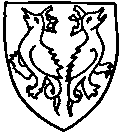Early Period Heraldry
by Lady Caitlin McDonnell
As a herald I realize that devices which are portrayed on a heater are not in period for early personas. Although early peoples did not have devices per se, many individuals did adopt symbols which proclaimed their identity. These symbols represented clan sigils, totem symbols or something which had special meaning for an individual. For example, in all the medieval rolls of arms and heraldic treatises which mention Uther Pendragon, the arms which are attributed to Uther are "Or two dragons addorsed vert crowned gules" (two green dragons with red crowns on a gold field). As a side note, all the earliest Welsh references associate the dragon with war-leaders and with fighting.
 In general, making a simple design will look more authentic. Local heralds will be glad to help you with your design. For colors, the two metals (gold and silver) and the colors blue, green, red and black are recommended. Use plain field divisions such as the following:
Ordinaries like chiefs (1), bends (2), fesses (3), or pales (4) work well. Plants, birds and animals were and still are good clan or totem symbos. The Gotland bird and interlaced birds and beasts are gradually being accepted. Hoewver, good documentation as well as good design are very important for geting these passed. Auxilliary military units attatched to the Roman Army had clan symbols which they placed on their shields. These will possibly give some good ideas with which to start.
There are some things which should be avoided. These are mostly late variations such as furs and fancy line divisions like figures 5 and 6:
In general, making a simple design will look more authentic. Local heralds will be glad to help you with your design. For colors, the two metals (gold and silver) and the colors blue, green, red and black are recommended. Use plain field divisions such as the following:
Ordinaries like chiefs (1), bends (2), fesses (3), or pales (4) work well. Plants, birds and animals were and still are good clan or totem symbos. The Gotland bird and interlaced birds and beasts are gradually being accepted. Hoewver, good documentation as well as good design are very important for geting these passed. Auxilliary military units attatched to the Roman Army had clan symbols which they placed on their shields. These will possibly give some good ideas with which to start.
There are some things which should be avoided. These are mostly late variations such as furs and fancy line divisions like figures 5 and 6:
 5.
5.
 6.
The Sagitaiary (Sagitarius) appears about 1135. The mermaid ws known to the Celts, the Teutonic tribes, the Vikings and the early English. The merman was rare as a heraldic charge. Lions and eagles abound and will be hard to get passed, as will dragons. The sea lion does not appear until the sixteenth century. The panther appeared about 1394. The double-headed eagle is an early decorative motive in Middle Eastern countries but by 1443 became limited tot he Holy Roman Emperors. Martlets (a combination of the swift, the swallow and the house martin) appear as early as 1127, and signify theat thebearer acquired nobility by his bravery and prowess or by his intelligence, having begun with little wealth.
Please remember that your imagination and research can make your device signify "Here I am". The better you understand who and what your persona is, the easier it will be to design a device. The herald's office registers devices on a heater shape and badges on a roundel. You do not have to display your arms in that manner. Use whatever means will fit in with your period. Paint your arms on a round wooden shield shape with a cord onthe bgack for hanign, or copy Roman auxiliary standards.
Sources:
6.
The Sagitaiary (Sagitarius) appears about 1135. The mermaid ws known to the Celts, the Teutonic tribes, the Vikings and the early English. The merman was rare as a heraldic charge. Lions and eagles abound and will be hard to get passed, as will dragons. The sea lion does not appear until the sixteenth century. The panther appeared about 1394. The double-headed eagle is an early decorative motive in Middle Eastern countries but by 1443 became limited tot he Holy Roman Emperors. Martlets (a combination of the swift, the swallow and the house martin) appear as early as 1127, and signify theat thebearer acquired nobility by his bravery and prowess or by his intelligence, having begun with little wealth.
Please remember that your imagination and research can make your device signify "Here I am". The better you understand who and what your persona is, the easier it will be to design a device. The herald's office registers devices on a heater shape and badges on a roundel. You do not have to display your arms in that manner. Use whatever means will fit in with your period. Paint your arms on a round wooden shield shape with a cord onthe bgack for hanign, or copy Roman auxiliary standards.
Sources:
Fox-Davies, Arthur, A Complete Guide to Heraldry, Bonanza Books, NY, 1978.
Denny, Rodney, the Heraldic Imagination
von Volborth, C-A, Heraldry Customs, Rules and Styles
Barker, Phil, The Armies and Enemies of Imperial Rome, Wargames Research Group, Worthing, West Sussex UK, 1981.
 Back to Early Period #2 |
Back to Early Period Index
Back to Early Period #2 |
Back to Early Period Index
Back to PastTimes


 1.
1. 2.
2. 3.
3. 4.
4. 5.
5.



 5.
5.
 6.
6.
